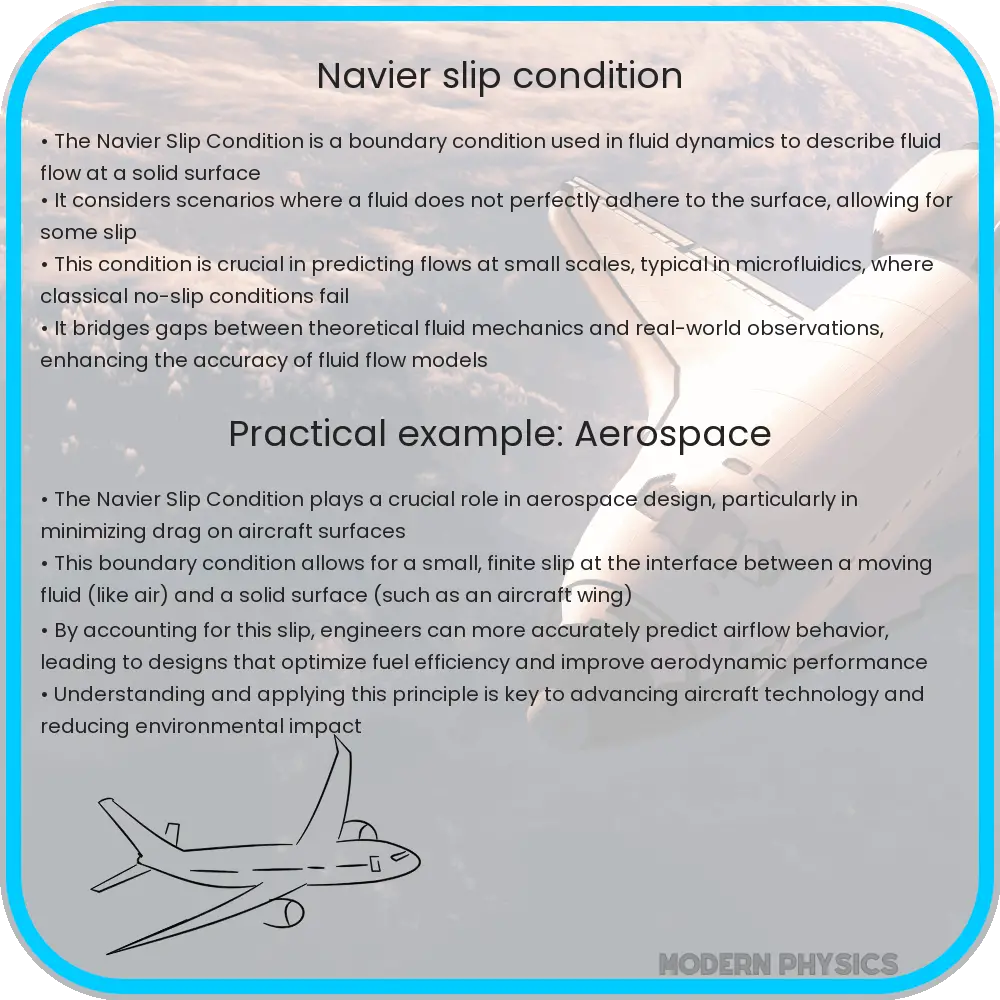The Navier slip condition in fluid dynamics allows for non-zero slip velocity at the boundary between a fluid and a solid, refining traditional no-slip assumptions.

Understanding the Navier Slip Condition in Fluid Dynamics
The Navier slip condition is an important fundamental concept in the field of fluid dynamics, particularly when analyzing fluid flow at the boundary between a fluid and a solid surface. This boundary condition, named after the French physicist Claude-Louis Navier, offers a more refined approach compared to the classical no-slip condition that assumes zero velocity of a fluid relative to a solid at their interface. Let’s explore what the Navier slip condition entails, why it’s important, and how it is applied in real-world scenarios concerning fluid flow.
What is the Navier Slip Condition?
The Navier slip condition allows for a non-zero slip velocity at the boundary between a fluid and a solid. Unlike the no-slip condition, which states that the fluid has the same velocity as the solid at the interface (usually zero relative velocity), the slip condition permits some degree of fluid slide over the solid surface. This is mathematically represented by the equation:
$$ v = \lambda \frac{\partial v}{\partial n} $$
Here, v denotes the slip velocity at the boundary, \(\lambda\) is the slip length, and \(\frac{\partial v}{\partial n}\) represents the velocity gradient normal to the surface.
The slip length, \(\lambda\), is a measure of the extent to which the fluid slips over the surface and is dependent on both the properties of the fluid and the characteristics of the solid surface. Typically, \(\lambda\) is very small and often approaches zero, which aligns with the more common no-slip condition. However, in scenarios involving extremely smooth surfaces or where the scale of the fluid flow is very small (such as in microfluidics), significant slip can occur.
Significance of Navier Slip Condition in Fluid Dynamics
The introduction of the Navier slip condition into fluid dynamics problems allows for a more accurate simulation of fluid behavior at the boundary, which is crucial in a number of practical applications. In classical fluid mechanics, assuming no slip can lead to discrepancies between theoretical predictions and experimental results, especially at small scales or high shear rates. Incorporating slip can provide a more nuanced understanding of the flow behaviors.
Moreover, the condition is pivotal for the study of flows involving non-Newtonian fluids or those where the interaction effects at the boundaries significantly affect the overall fluid behavior. Such situations include high-speed flows in microchannels, flow around nanoparticles, or the analysis of biological fluids in small-scale geometries. By accounting for the slip, engineers and scientists can more precisely design systems that optimize performance while accounting for the detailed interactions at the fluid-solid interface.
- Enhanced accuracy in computational fluid dynamics (CFD) simulations
- Better understanding and design of microfluidic devices
- Improved performance of lubrication in mechanical systems
- Detailed analysis of biomedical fluid flows, such as blood in capillaries
These examples illustrate just a few of the many applications where acknowledging the possibility of fluid slip is crucial. In the next section, we will delve into some specific real-world applications where the Navier slip condition plays a central role.
Real-World Applications of the Navier Slip Condition
The practical impact of the Navier slip condition can be observed across various engineering and scientific fields. Here, we’ll highlight some specific cases where understanding and applying this condition have proven invaluable:
- Microfluidics: In the design of microfluidic devices, which manipulate fluids at the microscale, controlling and predicting fluid behavior is essential. The Navier slip condition helps in designing more efficient microchannels and pumps, which are critical for applications in biomedical testing and chemical analysis.
- Lubrication Technology: In mechanical engineering, proper lubrication is crucial for reducing wear and tear and enhancing the efficiency of moving parts. The slip condition provides insights into the behavior of lubricants under extreme pressures and velocities, leading to more durable and efficient mechanical designs.
- Environmental Engineering: Understanding how pollutants or particles interact with water bodies involves studying the boundary layer flows. By applying the Navier slip condition, environmental engineers can better predict the dispersion and transport of pollutants, improving strategies for environmental protection and cleanup.
- Aerospace Applications: In aerospace engineering, minimizing drag and ensuring efficient boundary layer control are paramount. By incorporating the Navier slip condition, engineers can optimize the design of aircraft surfaces for better aerodynamic performance and fuel efficiency.
Conclusion
The Navier slip condition represents a significant refinement of our understanding of fluid dynamics, especially at interfaces. Unlike the simplistic no-slip assumption, this condition accommodates the complexities of real-world physical interactions between fluids and solids. Its application ranges from improving microfluidic devices that aid in medical diagnostics to enhancing the efficiency of aerospace designs. By enabling more accurate predictions and better designs, the Navier slip condition not only advances our theoretical knowledge but also delivers practical benefits across various technological and industrial fields.
For students, engineers, and scientists, grasping the implications of the Navier slip condition is fundamental to pushing the boundaries of what we can achieve in fluid dynamics, opening up new avenues for innovation and efficiency. As we continue to uncover more about fluid behavior, especially at small scales or under extreme conditions, the role of nuanced models like this one will only grow more crucial in crafting the technologies of tomorrow.
